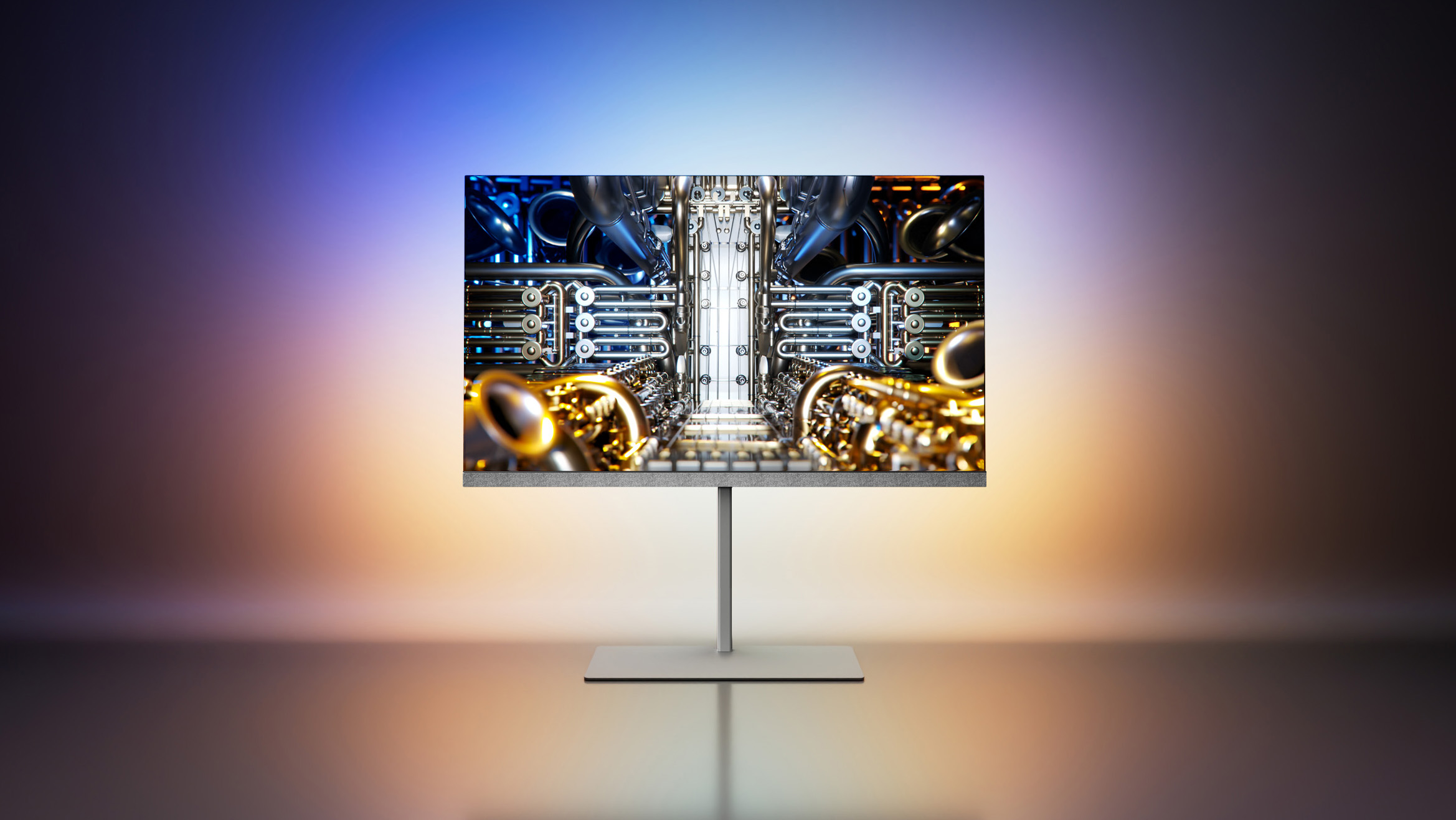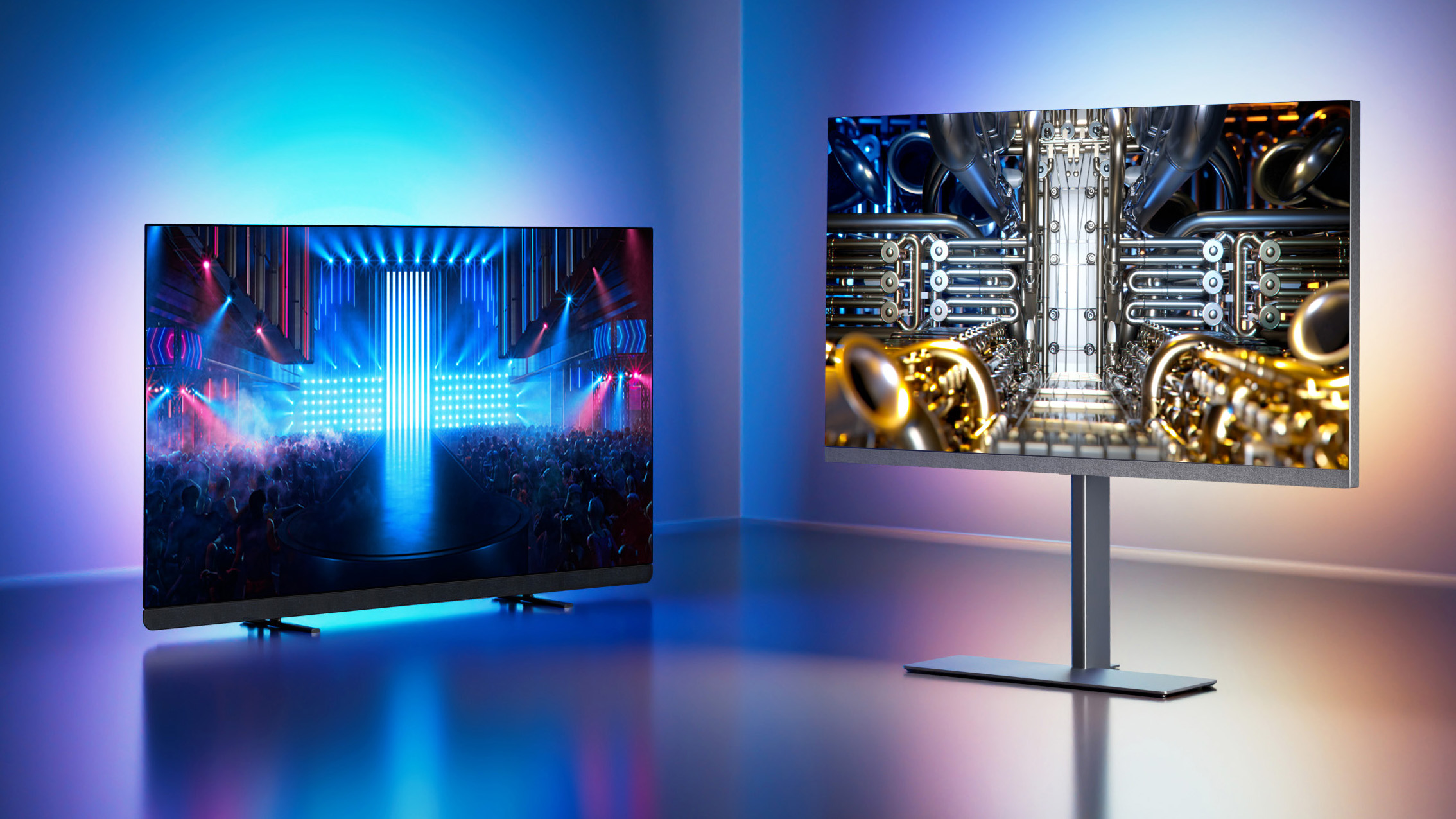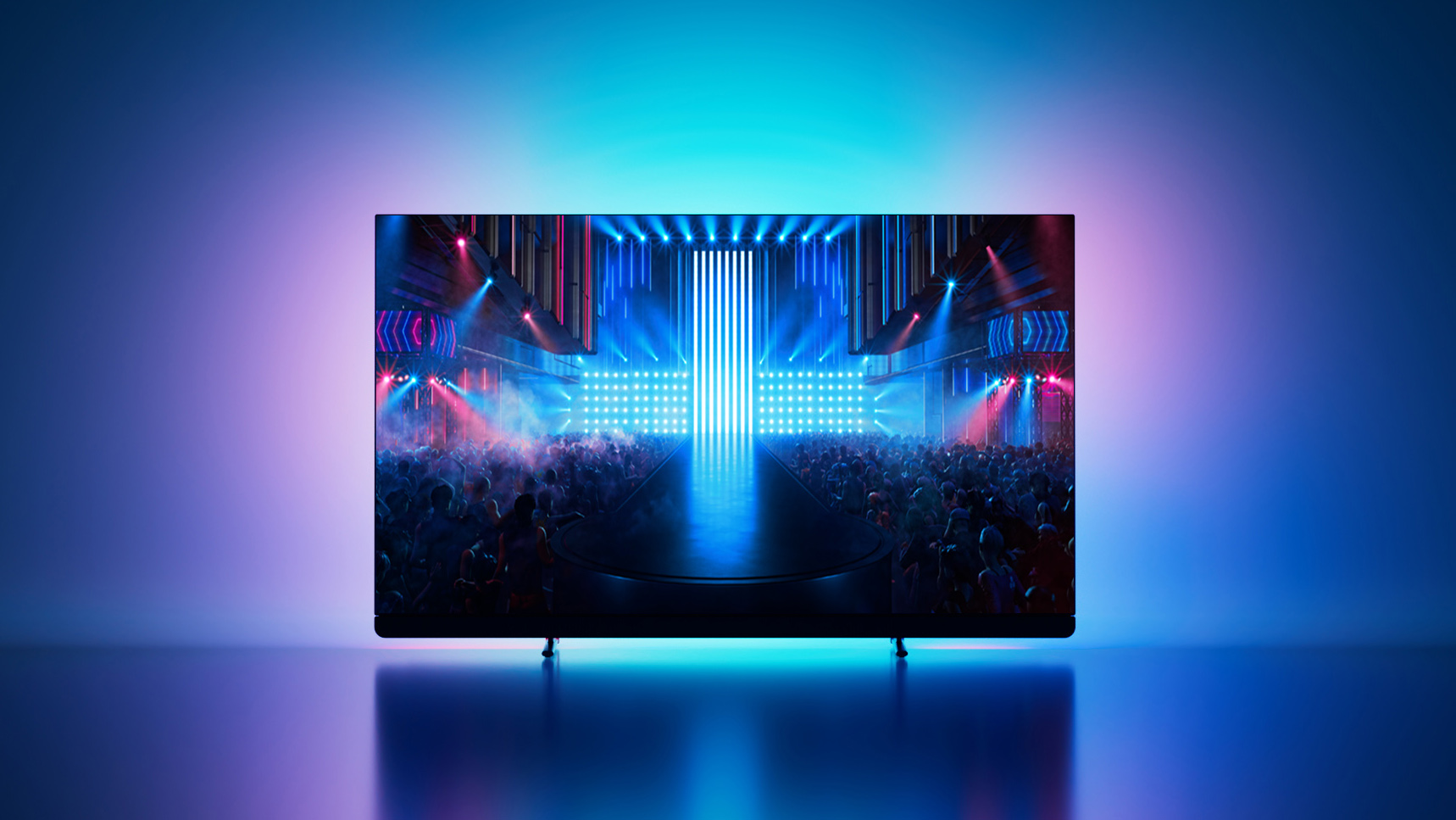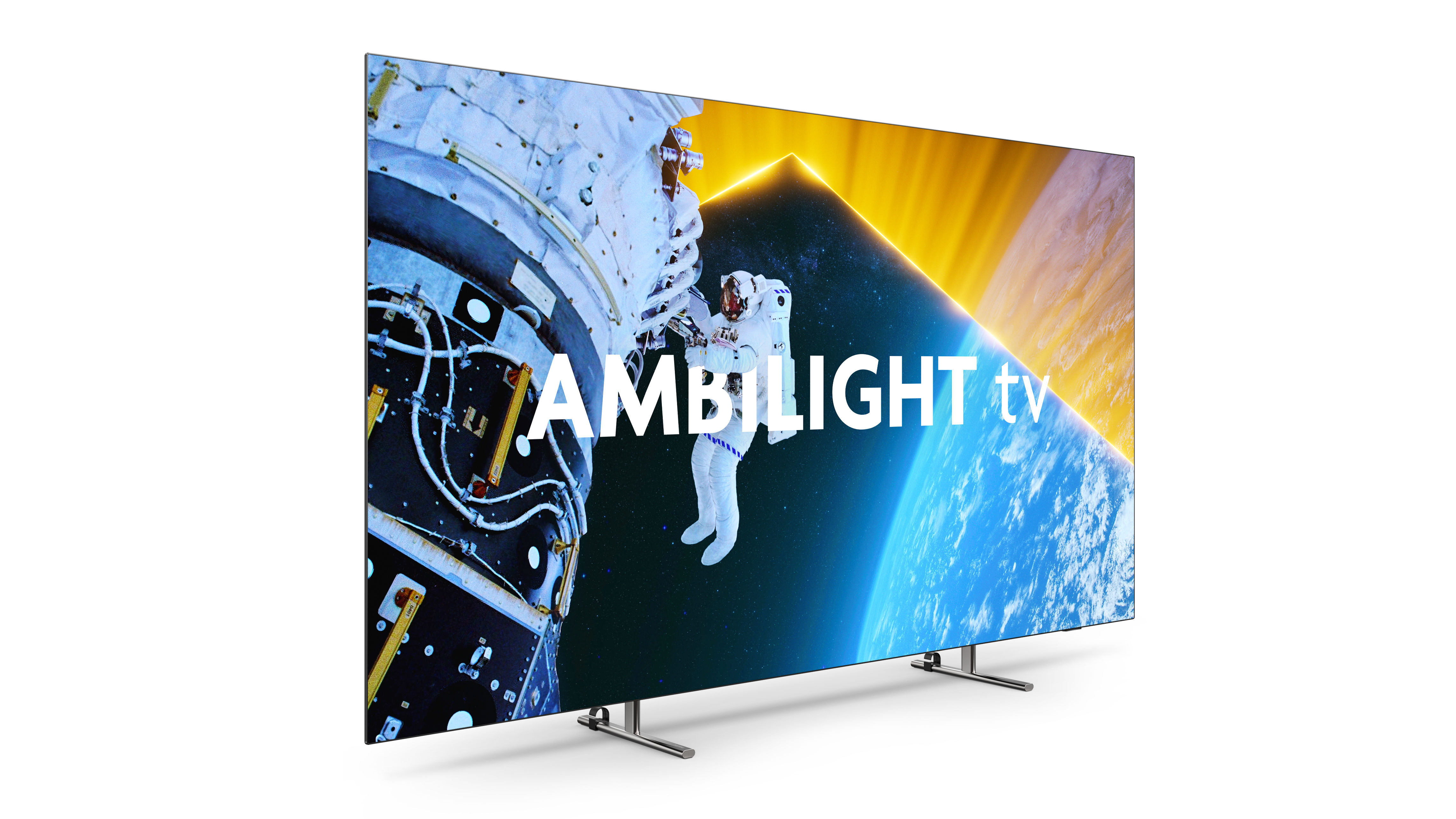
Philips has announced its TV lineup for 2024, which includes two new models in its OLED+ range, the OLED+909 and the OLED+959, which both promise to hit 3,000 nits of peak brightness using a new-gen OLED panel. There will also be a new mid-range OLED, new mini-LED models, and new affordable ‘The One’ model. No prices and release dates have been officially confirmed yet, but we expect the Philips to be unavailable in the US as usual.
Available in a 65-inch size, the Philips OLED+959 promises this new level of brightness thanks to the inclusion of the latest OLED panel with micro lens array (MLA) technology and META 2.0 brightness-handling algorithm, which we'll see on a few of the best OLED TVs in 2024.
The OLED+959 also features new Ambilight tech called Ambilight Plus, which Philips says will add more immersion with the ability to project up to four light halos with different levels of depth based on what’s on screen. It will also come with a 102-watt, 5.1.2-channel sound system designed and tuned by Bowers & Wilkins.
The OLED+909, available in sizes 55, 65 and 77-inch will feature an 81-watt 3.1 sound system, again developed by Bowers & Wilkins, with new slimline tweeters to allow for a thinner design. It won’t include the Ambilight Plus tech, but will have Ambilight on all four sides.
Both the OLED+959 and OLED+909 will feature the 8th-gen Philips P5 processor, though the OLED+959 will feature the more powerful Dual Engine version, and both support 144Hz refresh rate and Dolby Vision gaming. They will also come with Philips’ Game Bar for customisation of game settings.
Also in the OLED lineup is the Philips OLED 809, successor to the brilliant Philips OLED808, one of the best TVs of 2023. Available in a wide array of sizes ranging from 42 to 77 inches, this features a three-sided Ambilight and 144Hz gaming capabilities, plus higher brightness – Philips says this can hit 1,300 nits of peak brightness, which would put it close to the Samsung S90C. It will also feature the 8th-gen P5 processor.
Finally there's the Philips PML909, which uses a mini-LED panel that Philips says will hit a peak brightness of 1,000 nits and is available in sizes 55, 65, 75 and a new 85-inch model. It will also support 144Hz gaming.
There's also the PUS8909, known as The One, which serves as the premium LED model available in sizes ranging from 43 to 75-inch and also supports 144Hz gaming.
Below we take a more in depth look at each model in the lineup.

Philips OLED+959
The Philips OLED+959, Philips' flagship OLED for 2024, comes equipped with the 8th-gen P5 AI Dual Engine processor which is paired with the newest-gen LG Display OLED panel to produce up to 3,000 nits, according to Philips. Both LG Display and Samsung Display (the makers of all the OLED TV panels in the world) announced 3,000-nit displays for 2024, but this is the only TV so far that’s promised to hit these numbers. The LG G4 uses the same panel, but LG hasn’t promised any specific figures for its brightness; the Samsung S95D also uses a supposedly 3,000-nit panel, but has explicitly told us not to expect the TV to hit that level. So if Philips can pull all the potential out of the screen (the company is usually strong for brightness in its OLEDs), it’ll have something spectacular.
The OLED+959 will only be available in a 65-inch size, with wall-mounting and floor-standing options.
The company says that the new P5 AI Dual Engine chip will also enable videos in 8-bit color depth to appear as 14-bit levels of depth, thanks to Smart Bit Enhancement V3 algorithm. If this means nothing to you, that’s okay – in theory, it should help with color banding in darker areas in particular, which is where video doesn’t contain enough color data to have subtle gradation between colors, leading them to look blocky. Color banding is one of the biggest image-quality drawbacks of streaming’s limited bandwidth, so we hope Philips can really improve it.
In terms of gaming, the OLED+959 will support 144Hz, Dolby Vision gaming and Philips TV’s new Game Bar, which will allow you to tweak settings to the game you're playing, akin to game modes from LG, Panasonic and Samsung.
The OLED+959 will also come with a built-in 5.1.2 slimline speaker system from Bowers & Wilkins that will be housed within the frame of the OLED959+ itself. The system uses 18 speaker drivers in total, with forward-facing speakers, left and right speakers, and upfiring drivers for Dolby Atmos. It sounds similar to what you find in the Panasonic MZ2000, which is a fantastic speaker setup.

Philips OLED+909
The Philips OLED+909 also features the same next-gen OLED panel as the OLED+959, including the promise of 3,000 nits of peak brightness. Its single-processor version of the 8th-gen P5 chipset will include a load of upgrades to its processing with more ‘AI’ modes – standard stuff in 2024!
It will feature a 3.1-channel speaker system again developed by Bowers & Wilkins, with slim-profile 30 x 55mm drivers designed to fit inside the svelte OLED frame without adding extra bulk to the design. Size-wise, the OLED+909 will come in 55, 65 and 77-inch models.
For gaming, the OLED+909 will support 144Hz, VRR and the new game bar as well as Dolby Vision gaming.
Philips hasn’t said how many HDMI 2.1 ports these TVs will have, but we presume it’ll be two HDMI 2.1 ports out of four ports total, as with last year.

Philips OLED809
The Philips OLED809 is a mid-range OLED and successor to the OLED808, and will most likely rival the LG C4 and Samsung S90D in terms of spec and price.
Featuring an OLED EX panel, Philips claims it will hit a peak brightness of 1,300 nits, which if true would put it far beyond not only the LG C3, but also close to the LG G3, which we measured at 1,449 nits. It would also put it above the peak brightness of the Samsung S90C, a QD-OLED and our TV of the year for 2023.
For gaming, it will again support 144Hz refresh rate, Dolby Vision gaming and the new game bar system.
It will feature a three-sided Ambilight design as opposed to the four-sided Ambilight design featured on the more premium OLED+ models.
The OLED809 will be available in sizes 42, 48, 55, 65 and 77-inch sizes, and features a 70-watt, 2.1-channel speaker system (50W in the 42-inch). We would expect the 42-inch and 48-inch sizes to be less bright than the 1,300-nit figure, because these sizes always are in every other OLED TV that includes them (due to how tight together the pixels are).
Philips PML9009
The Philips PML9009 is the mini-LED model of the Philips 2024 TV lineup. Available in 55, 65, 75 and a new 85-inch option for 2024, the PML9009, named ‘The Xtra’, is claimed to output 1,000 nits of brightness. This is actually lower than other mini-LED models we've reviewed in the past, such as the Hisense U8K which we tested at over 1,500 nits peak brightness, which will be fine if it comes in at a low price – but as mentioned above, we don’t have prices yet.
The PML9009 will support 144Hz for gaming and also use a new Titan Smart TV platform, which we’ll hopefully hear more about soon. It will also feature three-sided Ambilight.
Philips PUS8909
The Philips PUS8909, part of ‘The One’ range, is an LED model that will come in sizes 43, 50, 55, 65 and 75-inch.
It will feature three-sided Ambilight and will also support 144Hz for gaming, alongside the latest P5 processor. If the price is right, it could be among the best gaming TVs when it comes to value.



!["[T]he First and Fifth Amendments Require ICE to Provide Information About the Whereabouts of a Detained Person"](https://images.inkl.com/s3/publisher/cover/212/reason-cover.png?w=600)



